
the MAM: GREEK TITANS
RETURN TO MYTH ABOUT MYTHS PAGE
Titans were a group of deities with great cosmic power and tended to be embodiments of great and often celestial concepts. The word Titan meant ‘stretcher’ in the sense that they ‘stretched with great recklessness to accomplish a great deed’. A great handful of these giants participated in a war known as the Titanomachy, a ten year war against the Olympians of which they lost and a great many of them were sent to Tartaros as a result.
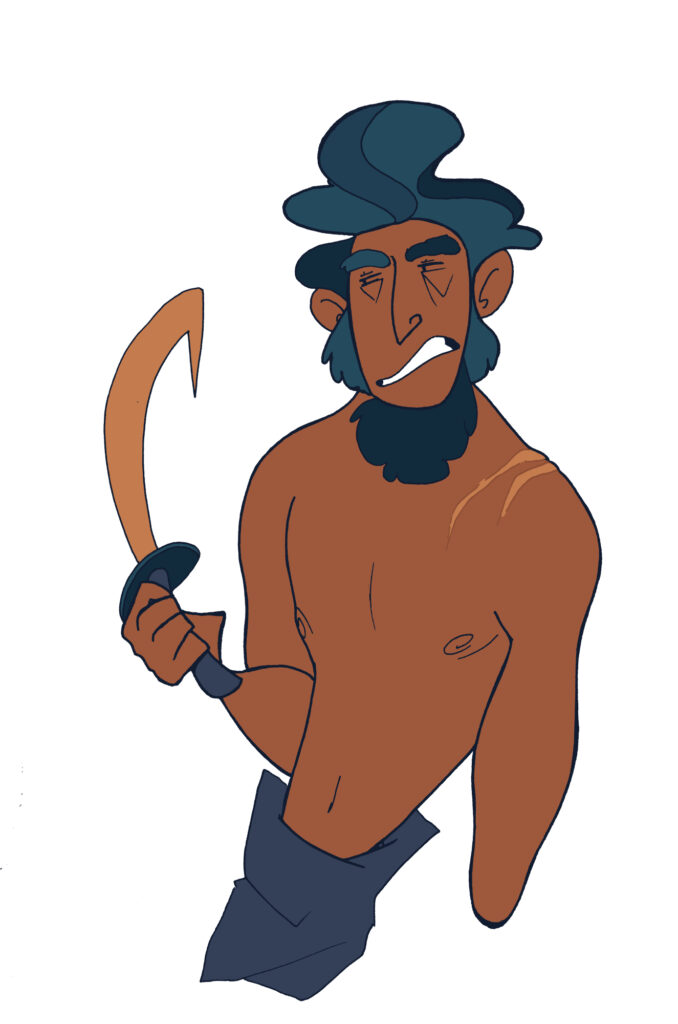
KRONOS
(KRONOS/KRONUS/CRONUS/OLYMPUS/OLYMBROS)
Titan of nothing in particular, once King of the Deities.
In some versions of the myth Kronos was most popularly known for the myth in which he was asked by his mother, Gaia to cut off his father’s penis. It was said that Kronos was rather eager at the chance to do so and when he did, he tossed the appendage into the ocean so that it could not be re-attached.
Afterward, Kronos was known for having various children with his wife and sister, Rhea. It was either prophesied or Kronos took notice as to how his own father was usurped at his hands and, not wanting the same thing to happen to him, Kronos took to his advantage and ate every single one of his children as they were born. Rhea replaced her final child, Zeus, with a rock which Kronos ate while the real Zeus was whisked away and taught how to fight. When he was ready, Zeus did usurp Kronos, giving Kronos a proper punch to the gut so that all his children were regurgitated.
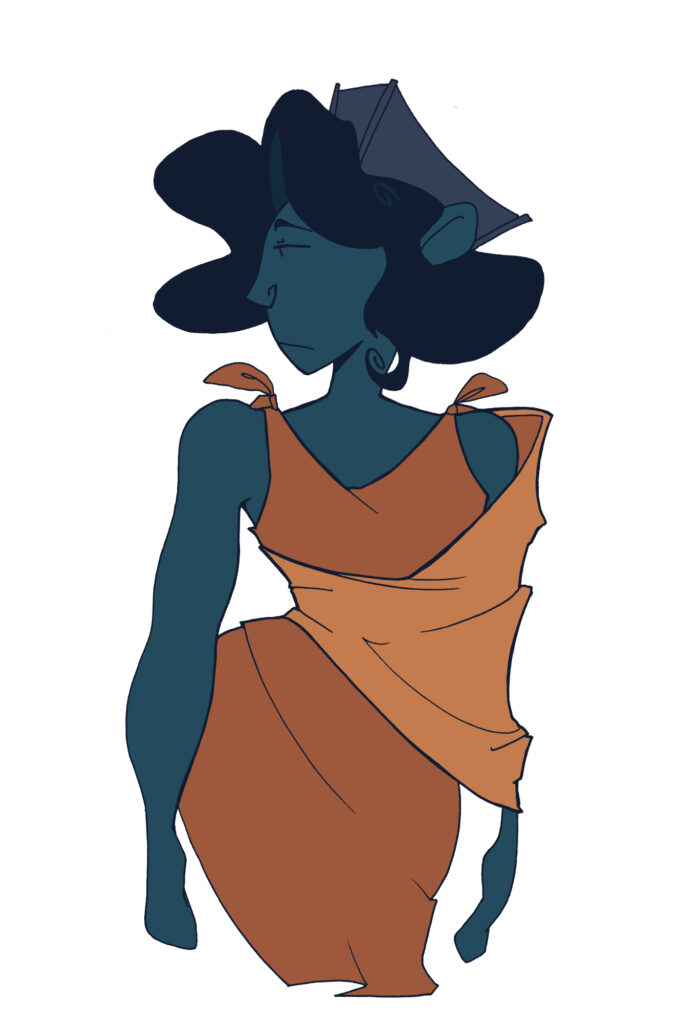
rhea
(RHEA)
Titaness of fertility, motherhood and the mountain wilds.
In some versions of the myth she was chosen by Kronus to bear his children despite not being particularly fond of the idea. Much less so when Kronus began eating his own children like a deranged madman. It was so terrible that Rhea eventually tricked Kronus into eating a rock in order to save her youngest son, Zeus and have him take on his father. Much to her surprise, this plan greatly succeeded and Zeus usurped his father.
Despite the seemingly shy nature of Rhea roles in myth, often she was depicted flanked by two lions and even standing on a chariot with lions pulling it.
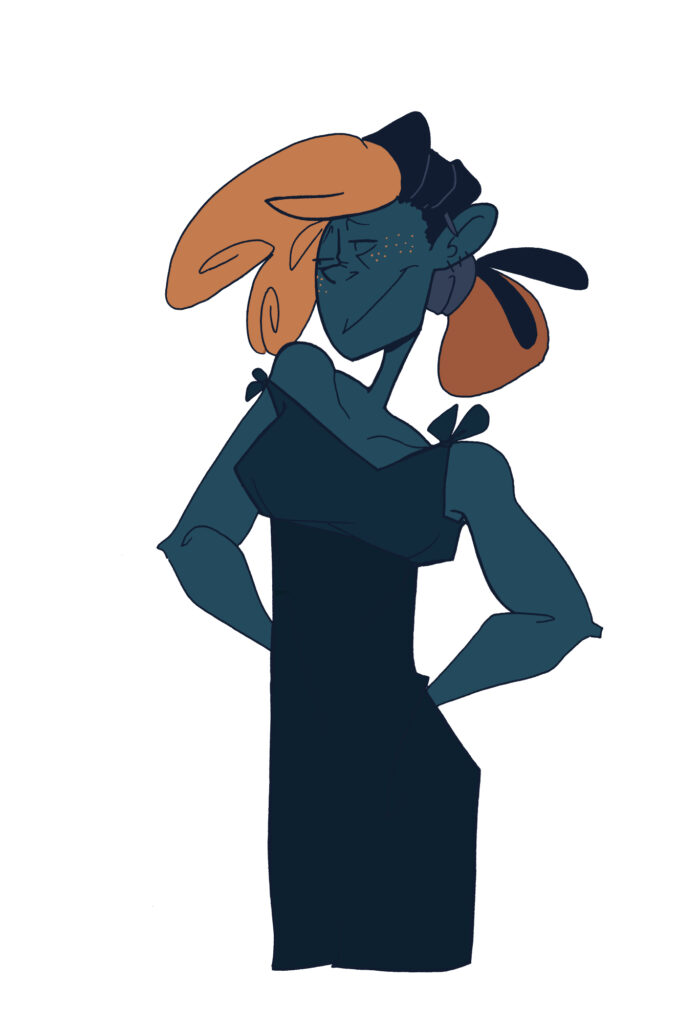
metis
(METIS)
Titaness of good counsel, advice, cunning and wisdom.
In some versions of the myth Metis was often considered Zeus’ first wife, though admittedly his traces are a bit difficult to keep proper track of. In any case, there was a prophecy being mused that Metis would give birth to a girl, and then to a boy so powerful he would overthrow his father. Zeus panicked at the mere thought of it, convinced Metis to turn into a fly so that he could swallow her whole. Knowing she was already pregnant and this would cause Zeus some strife in the process, she agreed. While trapped in Zeus’ stomach, Metis kept busy, making a proper helmet and an amazing set of armour. The turmoil of her machinations caused Zeus such a headache he asked Hephaestos to crack his head open with an axe. Hephaestos absolutely obliged at the offer, and in the process of cracking Zeus’ head open, helped give birth to Metis’ gorgeous daughter, Athena, fully clad in badass armour.
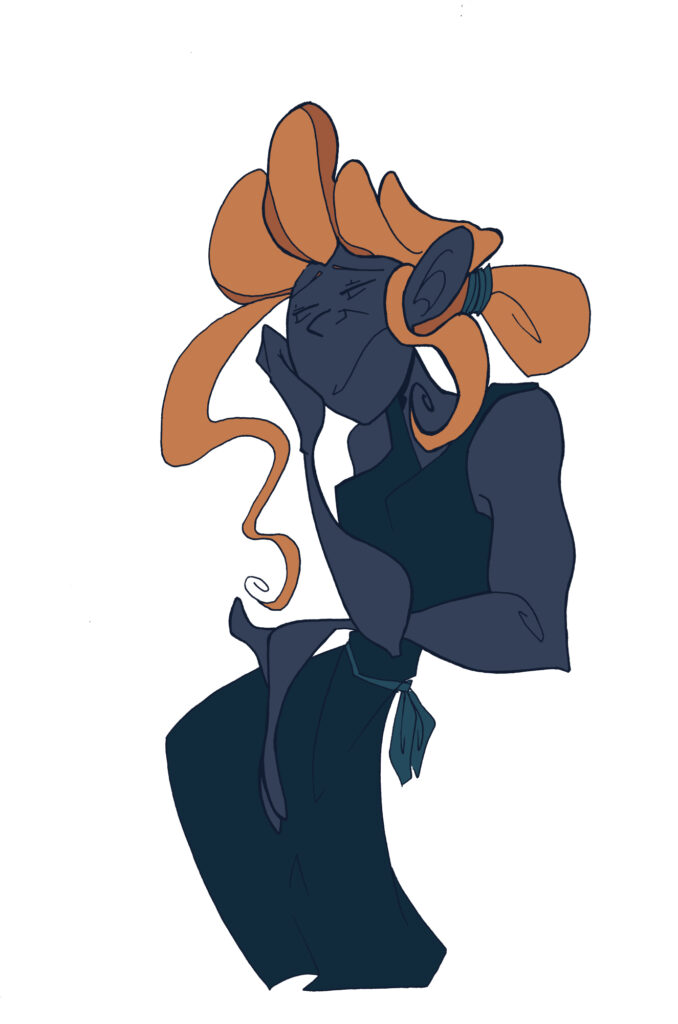
dione
(DIONE)
Titaness of the oracle of Dodona and springs.
In some versions of the myth, contradictory to previous statements, it was said that Dione was, in fact, Zeus’ first wife. However, in a different version of Aphrodite’s myth Dione was also Aphrodite’s mother. Dione didn’t play the biggest role in mythology but was often worshipped alongside Zeus as the goddess of the springs (water). They often built statues in her honour alongside Zeus.
In mythology, her only major role played was in helping to heal and console her daughter, Aphrodite after she was struck by Diomedes (in the hand…) during the Trojan war. She explained how several other gods were also struck by mortals and he would get his horrid consequence for his actions. Luckily for Diomedes, Dione couldn’t even really predict that right, he lived a very long life after the war on Troy.
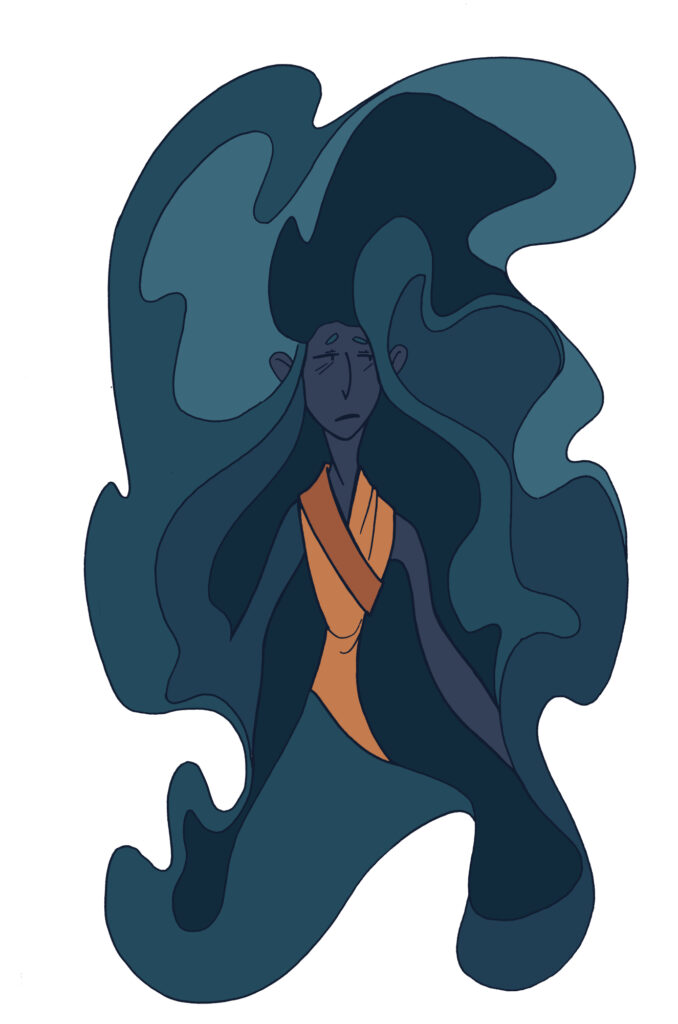
tethys
(TETHYS)
Titanness of fresh water streams, rivers, lakes, fountains…clouds.
In some versions of the myth Tethys was Hera’s nurse having raised her herself from a child onward. Therefore, Hera was a very closely connected with Tethys to the point in which Tethys was adamant with Zeus that Kallisto’s constellation (Ursa Major) never set below the horizon and touch the ocean as she was once a consort of Zeus and her interaction with the ocean, Tethys, would really upset Hera and cause her great jealousy to which Zeus happily complied.
While Tethys as a character didn’t play a huge role in mythology, her name was quickly and easily used to describe the sea and was often used in poetry.
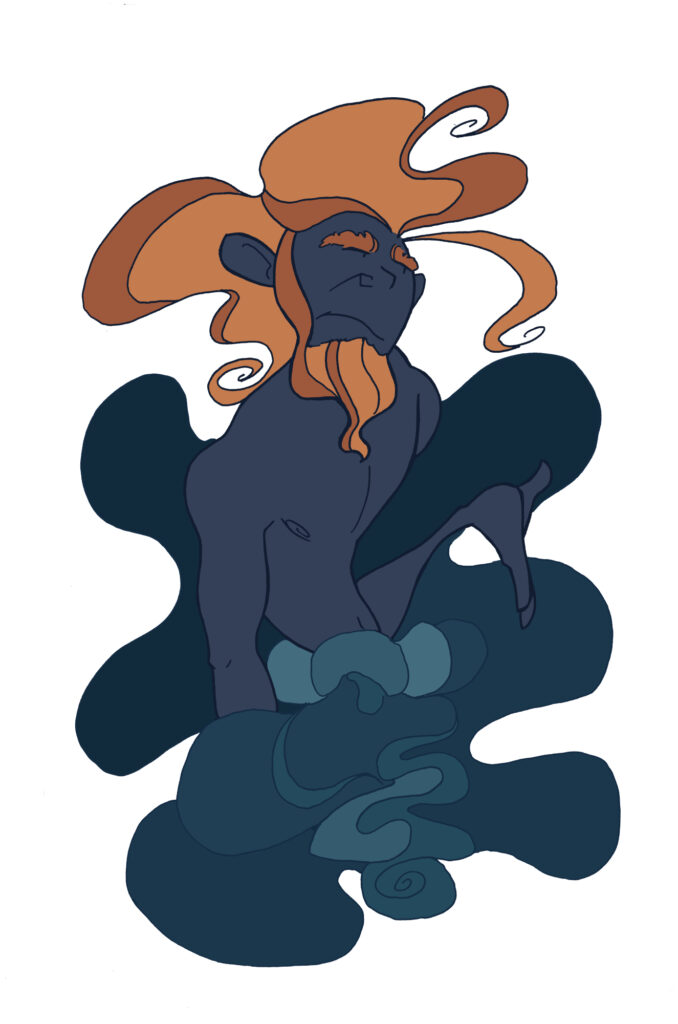
okeanos
(OKEANOS/OCEANUS/OGENUS/OGEN)
Titan of the sea (looked like a big river circling the world sometimes).
In some versions of the myth Okeanos was the personification of the ocean, a massive river of water encircling the world which blocked the land off and away from the Underworld. Although he, like his sister and counterpart, Tethys, didn’t play a huge role in mythology as a character, he was very often made reference to by other characters in various stories.
Okeanos also refused to take sides both in the efforts to usurp their parents (and aiding Kronus) and in the Titanomachy against the Olympians. Instead, Okeanos minded his own business and kept to his own struggles. Perhaps he and his consort were too busy having bout three-thousand children (known as the Okeanids).
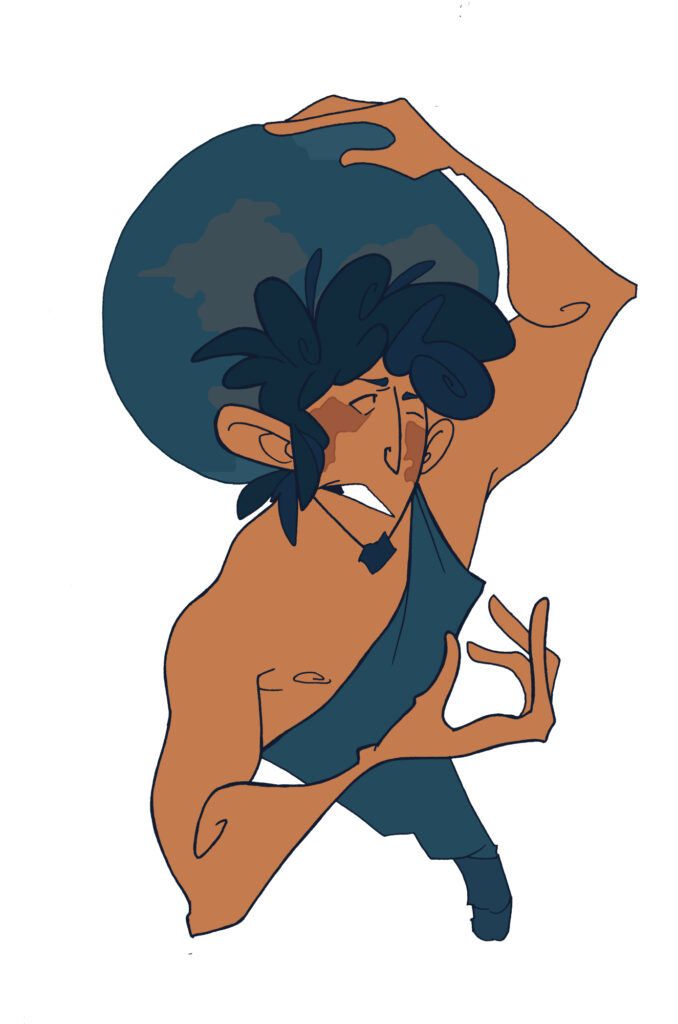
atlas
(ATLAS/TITAN)
Titan of holding up the world on his shoulders.
In some versions of the myth Atlas fought in the Titanomachy alongside his brother, Menoitios and while the Titans did lose this war, it was said that instead of condemning Atlas to the same fate of his siblings, he was punished with the task of standing at the western gate of Gaia and holding up the sky on his shoulders for the rest of his eternity. Interestingly enough this part of his myth was reinterpreted wrongly various times in which Atlas would eventually have been known for holding up the earth itself.
After this, Atlas reappeared again in the myth of Herakles during his eleventh labour. Herakles was tasked to fetch some golden apples in the garden of Hera. It was said that this garden was tended by Atlas’ daughters well known as the Hesperides (often this garden was known as ‘the garden of the Hesperides’). It was said that they were also guarded by a serpent-like dragon named Ladon. In some versions Herakles slew Ladon and ventured forth, noticing Atlas and his predicament. Atlas spoke to him, talking to the young hero about his journey’s and offered to fetch the apples for Herakles, the only catch was that the hero would have to hold up the sky in his place. Herakles took to the Titan and agreed to take his place in the meantime. Atlas convinced his daughters to hand him some of the golden apples. In some versions, when Atlas returned with the fruit he intended to run away with his newfound freedom. Herakles, figuring this, asked Atlas to hold the heavens for a moment while he adjusted his cloak. When Atlas took the sky back, Herakles snatched the apples and ran off to complete his labour. In a much better version of the myth, Herakles took pity on the Titan who had suffered this punishment for such a long time he liberated Atlas by building him two large pillars so that Atlas could be free.
In some cases, when the myth continues in which Atlas becomes a king and is faced with Perseus, son of Zeus, the Titan was so distressed by the prophecy in which a son of Zeus would steal his golden apples and banished Perseus from his kingdom. It was said that, unfortunately, Perseus used Medousa’s head to turn him and an entire mountain range into stone, his freedom rather short-lived.
Atlas was a name that was often utilized later on and in some cases it was said that Atlas was not, in fact, the Titan holding up the sky but was actually the very first king of Atlantis. Here we was the son of Ouranos and Gaia.
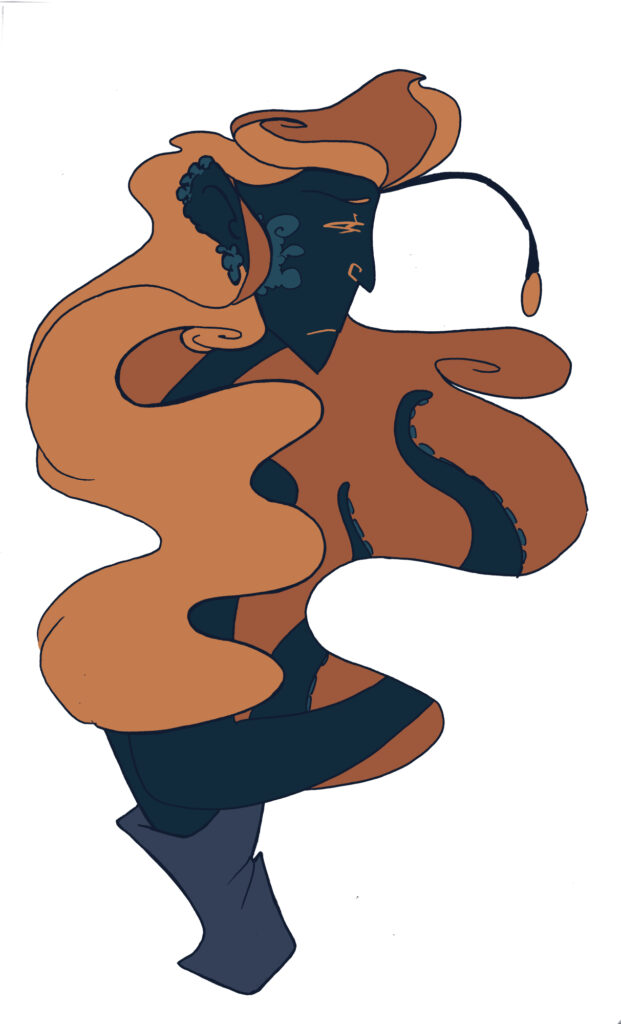
phorkys
(PHORKYS/PHORCYS)
Titan of the hidden dangers of the deep (sea).
In some versions of the myth, he made love quite incessantly with his wife, Keto. They kept themselves so busy they created a great deal of very monstrous children. These children included: a giant crab that devoured passing sailors, a hundred-headed sea serpent, a sea-viper, perhaps the gorgons, and various other monsters with varying ancestry.
He was not mentioned in grave detail although it in some cases he was confused with Poseidon who seemed to mirror a lot of this particular titan’s roles. In some cases it’s theorized that Poseidon usurped this titan as these mythological stories aged through mortal generations.
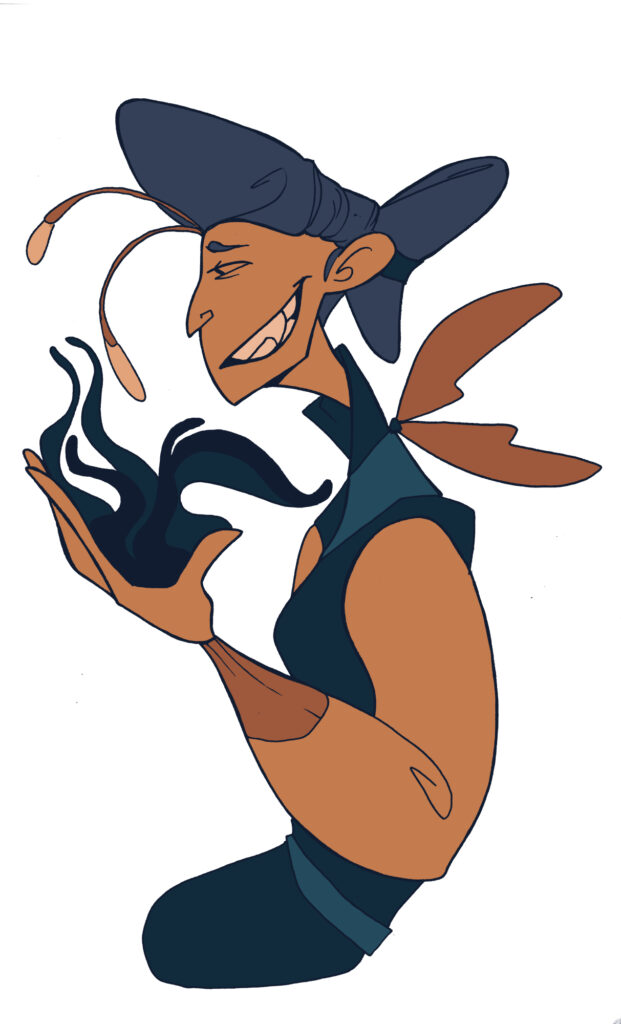
keto
(KETO/CETO)
Titanness of the hidden dangers of the deep (sea), most specifically sea monsters.
In some versions of the myth, Keto made love frequently with her brother and consort, Phorkys. Not only did the two of them create various sea-monsters but Keto was also responsible for creating all the creatures and fish in the sea. It was said she was also the mother of Echidna as well who, herself mothered a lot of land-dwelling monstrous children of her own.
Otherwise, aside for her relations with Phorkys, Keto is hardly made mentioned to in mythology save for a hero or two cursing her name when the next horrific monster is around to slay and destroy.
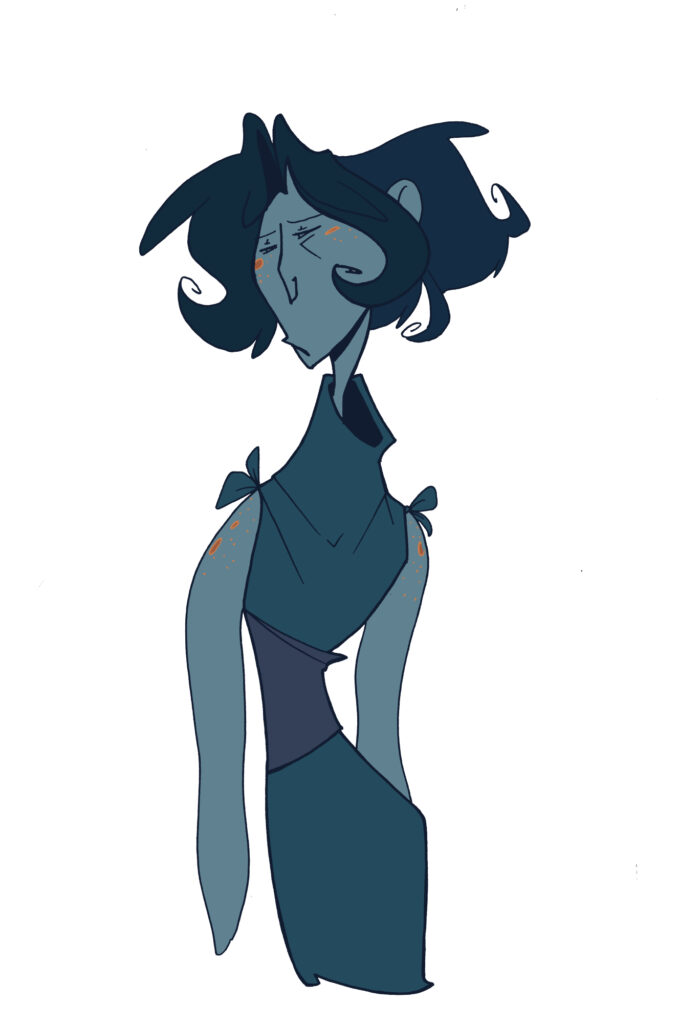
eurynome
(EURYNOME)
Titaness of water-meadows and pasture lands.
In some versions of the myth, Eurynome was one of two possible titles. She was either daughter of Okeanos, and the eldest of his daughters, and the third bride to Zeus in which she bore him three daughters. She was also one of the titans who caught Hephaestos (with her sister, Thetis) in his fall from Olympus after Hera cast him out, having been disgusted at her not-so-perfect lineage. Eurynome helped her sister nurse him back to health.
Or, Eurynome was also known as the Queen of the Titans and ruled with her husband Ophion who both resided on Olympus before they were cast down by Kronus and Rhea… Only for them to be usurped by Zeus and Hera not too terribly long after.
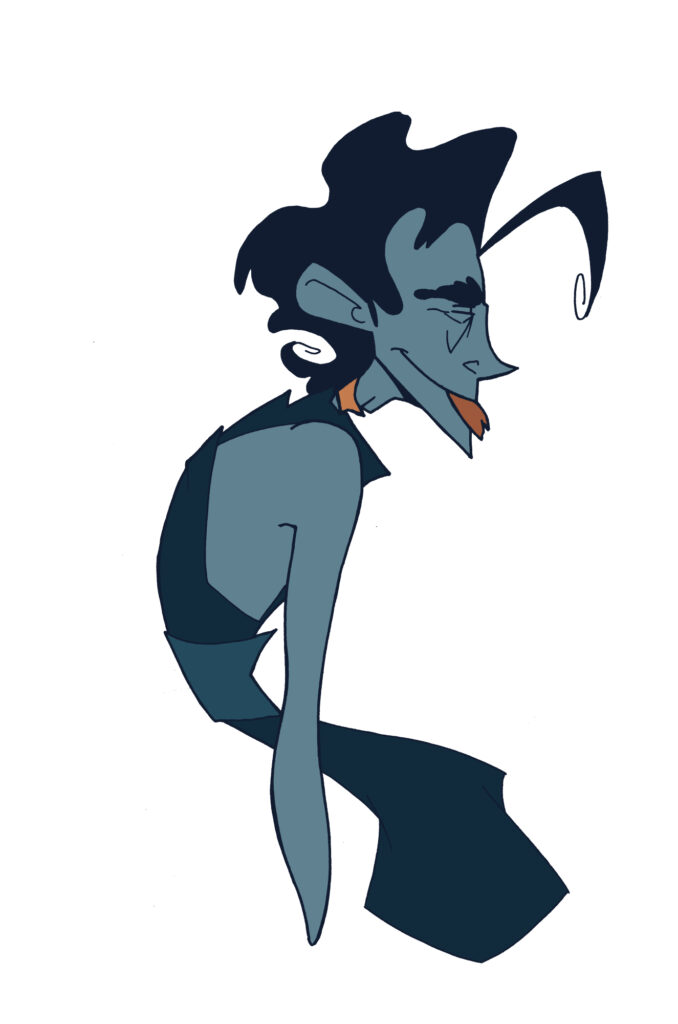
ophion
(OPHION/OPHIONEUS)
Titan of Age and Ancient times.
In some versions of the myth, Ophion was best known as the ruler of the titans before Kronus and Rhea usurped he and Eurynome. More current interpretations seek out a more obscure version of their mythology in which Ophion was created by Eurynome as a serpent. As a dove, she created an egg that which became fertilized by Ophion and gave birth to the world as is known by man. The two resided on Mount Olympus and the myth in which they were usurped by Kronus and Rhea remains the same.
The world-created-by-a-serpent-and-an-egg theory is not particularly novel, this imagery was seen with both Khronos and Ananke who had a very similar origin-myth before the idea was changed to something far more understandable via Gaia and Ouranos.
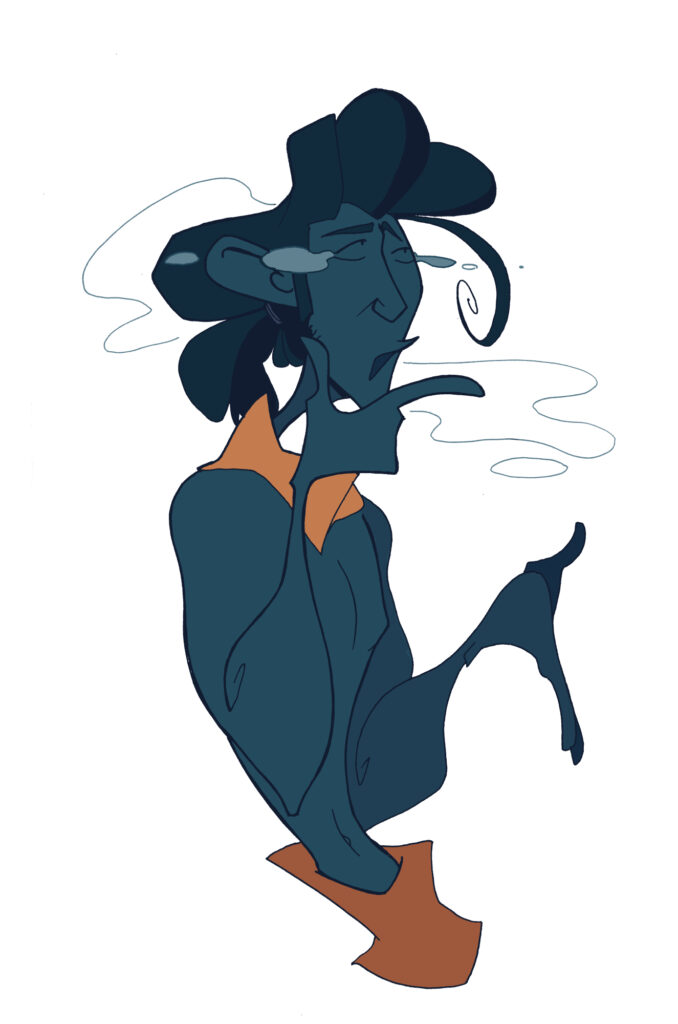
oizys
EPIMETHEUS)
Titan of afterthought/hindsight, also known as ‘Prometheus’ idiot twin brother’.
In some versions of the myth it was said that Epimetheus and Prometheus were in charge of giving every living creature on Earth, ‘traits’ and when Epimetheus had only humans left to give traits to, he possessed no foresight to remember to do so.
This anecdote only preludes this following scene. After Prometheus was caught giving fire to the humans and was sentenced to his horrid fate, he told his brother not to accept any gifts from Zeus, none at all. They could be traps. Unfortunately, as Epimetheus was the titan of hindsight, when Zeus came knocking at Epimetheus’ figurative door with Pandora in tow, he completely forgot what Prometheus had told him and was too busy watching Pandora’s jar dispel all kinds of evil into the world. Afterwards? He married her.
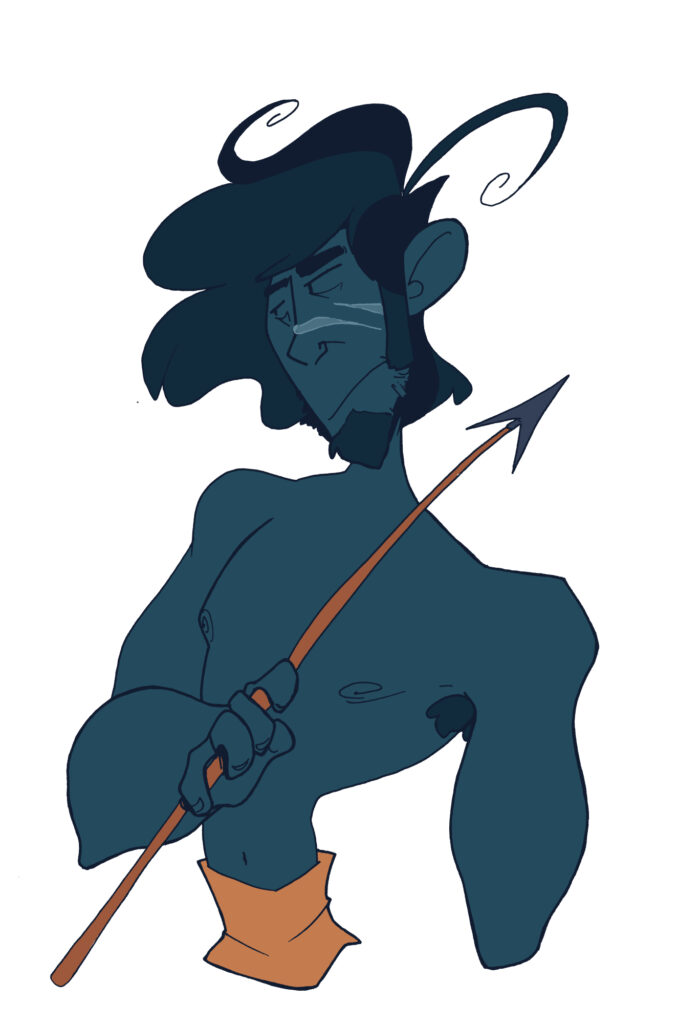
iapetos
(IAPETOS/IAPETUS/JAPETUS)
Titan of mortality and/or craftsmanship.
In some versions of the myth Iapetos wasn’t all that well known for doing all that much in mythology. It was said and hinted that he may have participated in the Titanomachy as he was mentioned to have been sitting alongside Kronus in Tartarus for his crimes.
It was also said that he was the origin of mankind all things considered this theory makes quite a lot of sense considering Prometheus was said to have crafted humans as well. Myth also insists that humans inherited a lot of the negative traits of our being from Iapetos’ sons: crafty/sneakiness (Prometheus), stupidity/afterthought (Epimetheus), endurance/stubbornness (Atlas) and daring/violence (Menoitios).
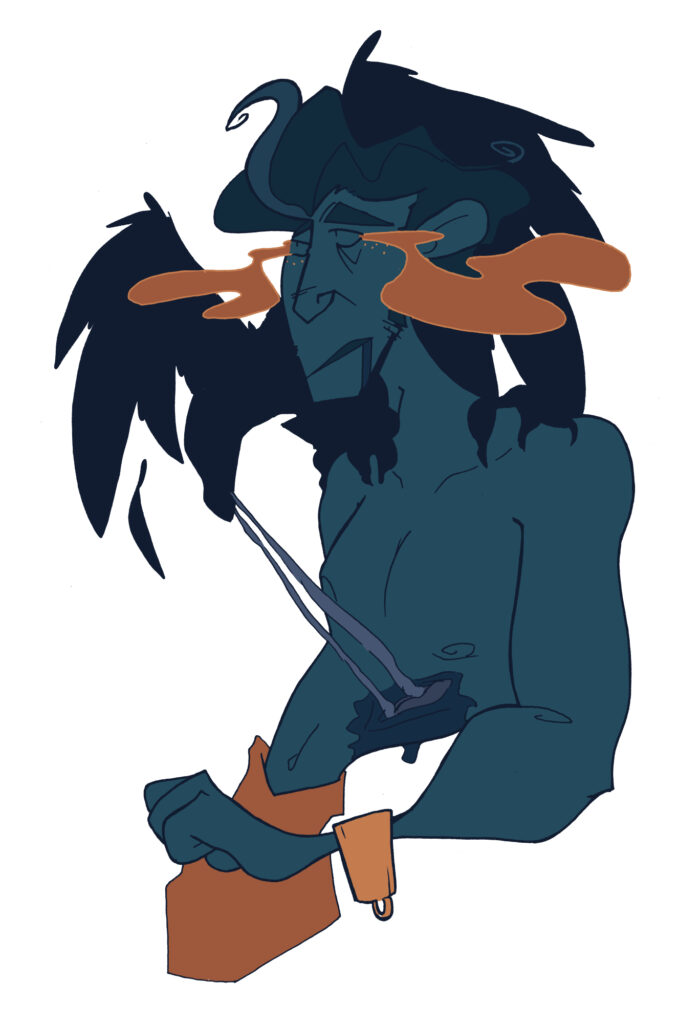
prometheus
(PROMETHEUS)
Titan of forethought and the creator of mankind.
In some versions of the myth it was said that while the Titanomachy occurred, Prometheus played very little and/or stayed mostly towards the sidelines in the entire ordeal which mean that he was not punished along with the rest of his sibling and sentenced to a lifetime in Tartaros.
Instead, Prometheus was given the task of moulding mankind out of clay. He was quite essentially the literal creator of humans which was interesting considering Zeus’ reign as king of both gods and mortals.
Unfortunately, Prometheus’ fondness for his creations meant that he severely butt heads with the Olympian. It was said that Prometheus withheld the best part of the feast of the gods and saved it for men as when men sacrificed the gods ate all the good meat and reserved only small scraps that were hardly even edible for mortals. It was said that Zeus caught the mortals eating this scrumptious meat and then punished them by taking away their ability to make fire. Prometheus, rather sore about this ordeal, wound up sneaking some fire hidden in a fennel-stalk and gave it to mankind.
Much to their dismay, Zeus found out about this treachery as well and rather than be civilized about it, he ordered the creation of Pandora (at the hands of Hephaistos, Hermes and Aphrodite) to be given to Epimetheus and unleash horrors and plague upon mankind and all their future generations. In the meantime, Zeus also punished Prometheus for his crimes and was sentenced to an eternity of punishment. He was bound to a stake on Mount Kaukasos where an eagle was set to feast on his regenerating liver (in some versions, his heart).
It was said that much later, like his brother Atlas, Herakles found Prometheus during his labours and in an attempt to complete them, also pitied the Titan and set him free of his bonds and his eternal punishment.
Interestingly enough, Prometheus’ story was one that carried greatly from one generation to the next and was a mythical character that was often depicted not only in the arts of antiquity but quite frequently in artwork throughout history to even modern-day adaptations.
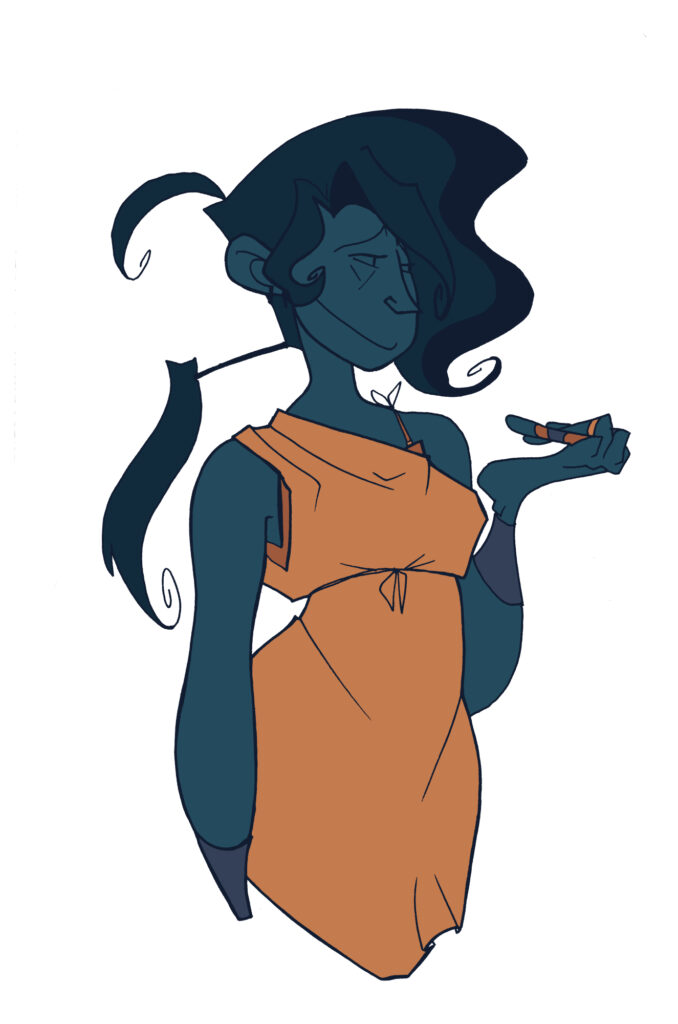
klymene
(KLYMENE/CLYMENE/ASIA)
Titaness of renown fame and infamy.
In some versions of the myth Klymene was the mother of four sons: Atlas, Prometheus, Epimetheus and Menoitios and was Iapetos’ wife. Unfortunately regardless of the fact that Klymene was supposedly the titaness of fame/infamy she was rather private and kept to herself. She is hardly if at all mentioned in mythology to the point in which some folks studying myth can hardly parse through the disambiguation on whether she has a sister named Asia or is also sometimes referred to as Asia. It really is rather unfortunate considering her sons were such prominent figures in mythology it could easily be assumed that Klymene was quite a character of her own if mostly reserved for ancient greek women to pass stories about through word of mouth.
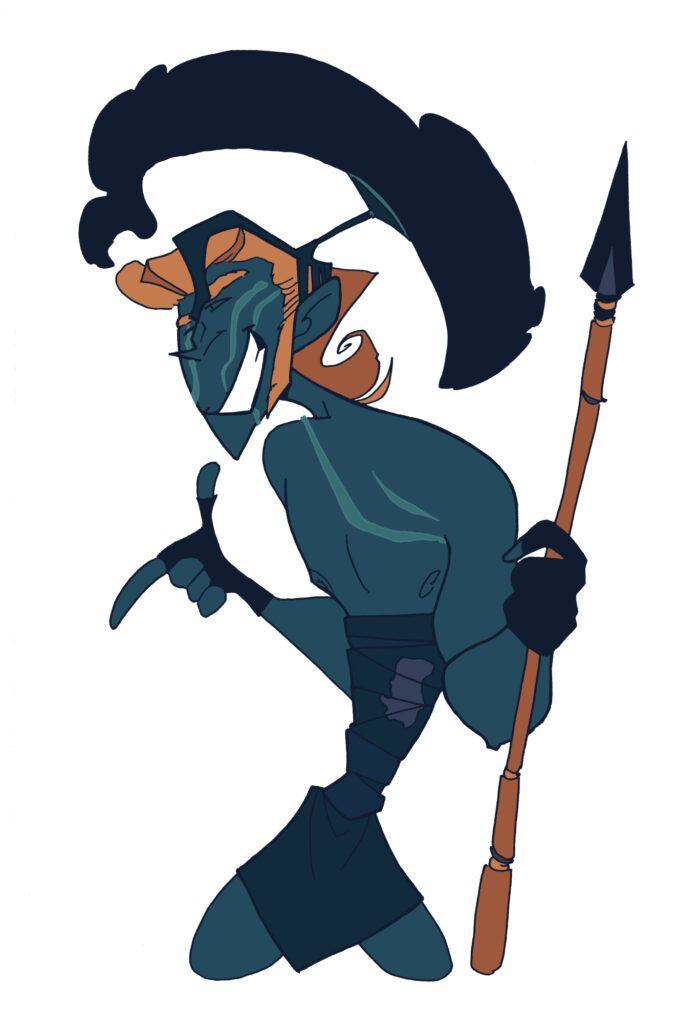
menoitios
(MENOETIOS/MENOETIUS/MENOETES)
Titan of violent anger, rash action and human mortality.
In some versions of the myth, Menoitios was best known as the son of Iapetus and Klymene, brother of Prometheus, Epimetheus and Atlas. Considering his role among the titans it was to absolutely nobody’s surprise that this character found himself enlisting and fighting in the Titanomachy (a war between Titans and Olympians). Menoitios was a ridiculously hubristic and brash titan and found himself in a fight of strength, will and power against Zeus who couldn’t back down from any sort of challenge either. It was all in good fun, Zeus perhaps even enjoying himself a little in the process until things became redundant and boring and Zeus finally struck him dead with his lightening bolt. Menoitios was sent to tartarus with the rest of the titans who lost the war and were on the wrong side.

Ankhiale
(ANKHIALE/ANCHIALE)
Titaness of the warming heat of fire.
In some versions of the myth, Ankhiale was born from Iapetos, making Prometheu’s her half-brother. She was married to the god of working hands, Hekateros and had a child who was considered the entity representing fingers, Daktyloi. Together it was said they were created to represent man’s ability to create fire which was a very humble and endearing sentiment all things considered. Ankhiale sounded like she might have been an interesting figure to know more about even though this is the extent of her mention in mythology.
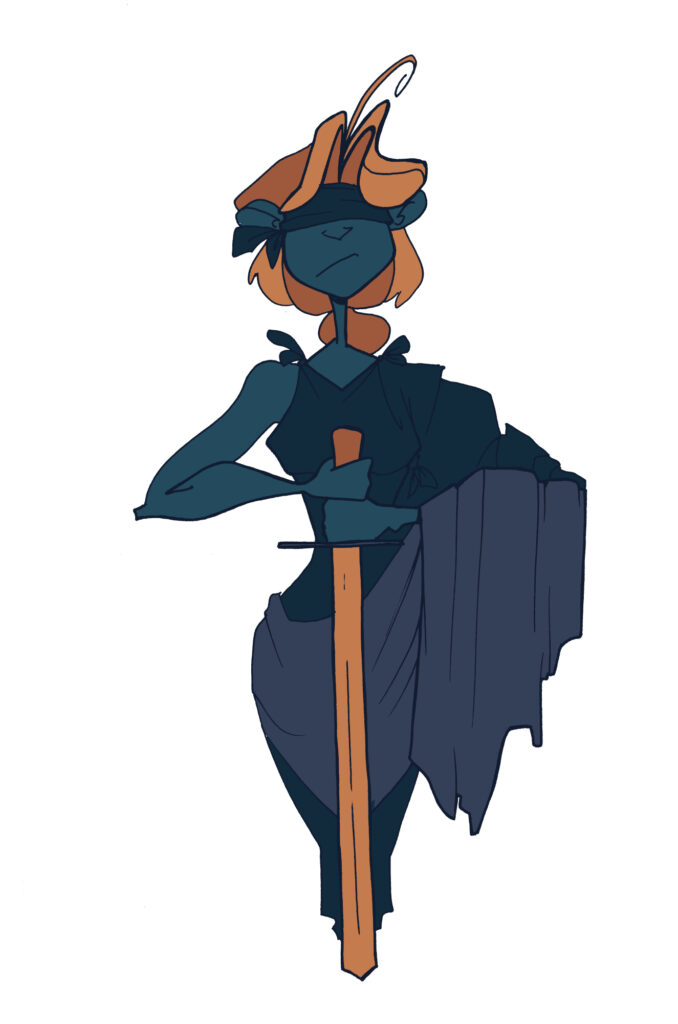
themis
(THEMIS)
Titaness of divine law and order.
In some versions of the myth Themis was the titaness who saw order to relationships between men, women, any folks in between and their families. Themis was adamant about keeping things fair, just and right. She was often depicted with her ‘scales of justice’ measuring fact from fiction and slicing away the lies with the use of her sword. Had she found out if someone were lying and being unjust she didn’t hesitate to cut them down. Not to confuse her with Nemesis (goddess of vengeance), Themis was foresight and insight, making certain things were set right. However, the two did share the same temple.
In mythology itself, Themis was deemed the one of the Oracles at Delphi for her great wisdom and insight. In some versions she built it herself, in others she was gifted the Oracle at Delphi by Gaia and later gave it to Phoebe. Themis was noted as one who consoled Hera after she was threatened by her husband, Zeus. Themis also made an appearance at the birth of Apollo and was present in the myth of Deucalion, telling him to toss stones ‘made from his mother’ over his shoulder to recreate man.
Although Themis didn’t feature in her own myth, she certainly made the rounds and participated in several.
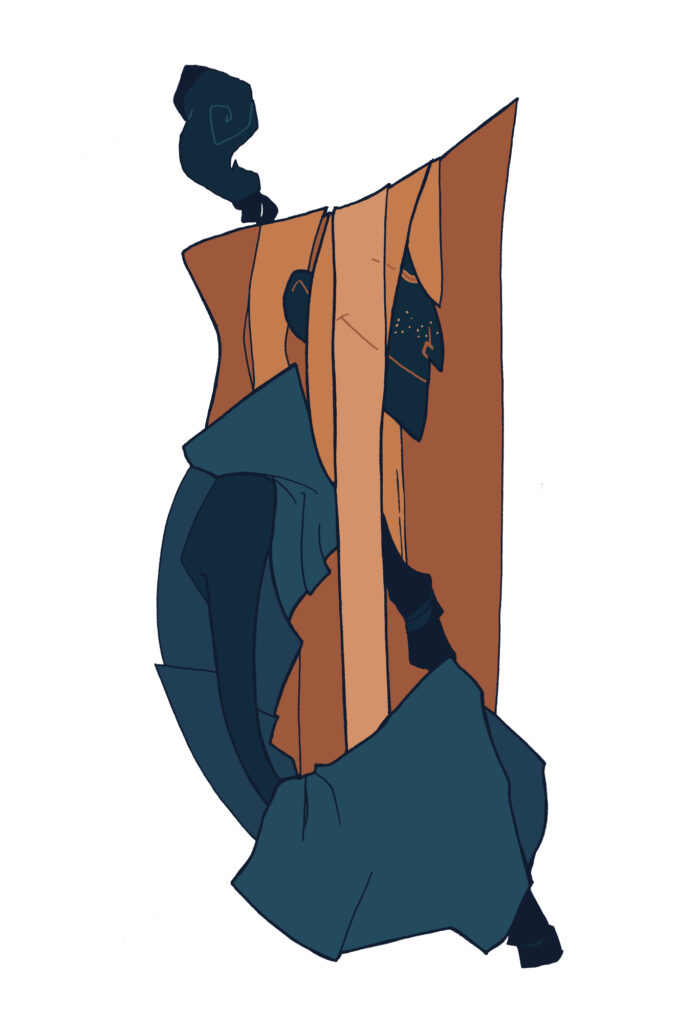
styx
(STYX/STIKS/STIX)
Titaness of the river Styx and the personification of hatred.
In some versions of the myth Styx was both a titaness and personification of the most famous river which divided the world of the living from the world of the dead. In some recounts she was the ferrywoman and keeper of the souls until this position was taken up by Kharon.
In the Titanomachy, Styx sided against her own kind and with Zeus. It was decreed afterward that any oaths made would have to be made in her name in order to be considered legitimate. This caused a great deal of turmoil and strife because these oaths had to absolutely be seen through to their bitter end despite that end being the death of the moral in question.
It was also said that the waters of her river were capable of making people invulnerable. This was how Achilles was such a great warrior, albeit the struggle with his weak ankle, the only part of him not covered by the water he was dunked in.
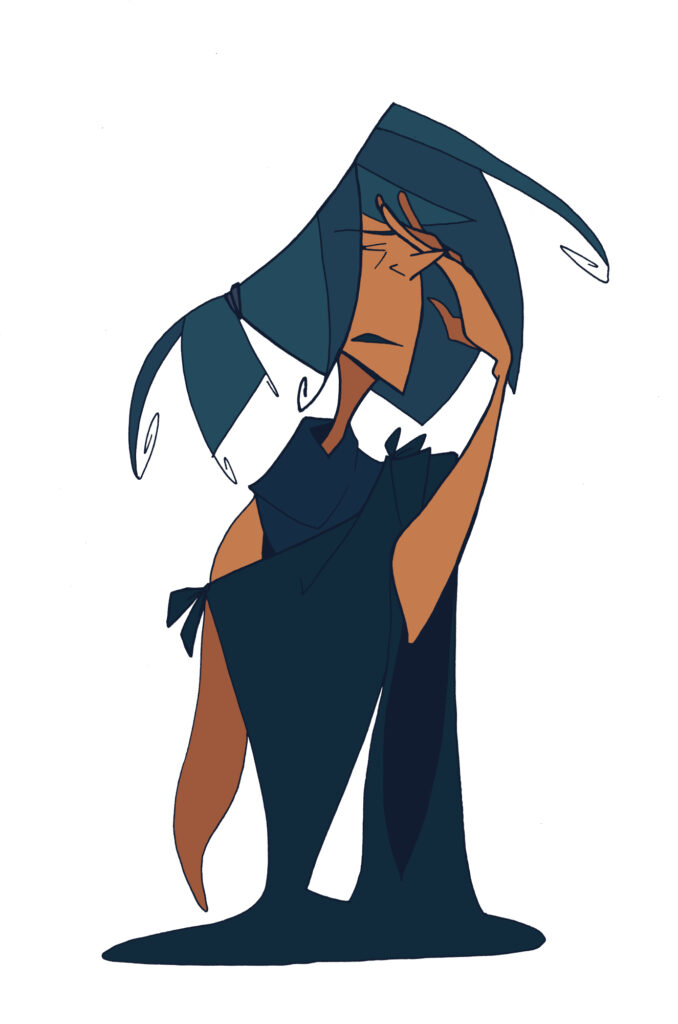
mnemosyne
(MNEMOSYNE)
Titaness of memory.
In some versions of the myth Mnemosyne was known best as the mother of the nine muses: Calliope, Clio, Euterpe, Erato, Melpomene, Polyhymnia, Terpsichore, Thalia and Urania. They were conceived in which Mnemosyne was deceived by Zeus who disguised himself as a humble shepherd and slept with Mnemosyne for nine consecutive nights.
In myth, Mnemosyne was also the overseer of a pool in the Underworld (although some say this was the river Lethe) in which souls drank the water from it so that they could forget their past lives when they were reincarnated. Alternatively, in later myth souls were taught to drink from the river, Mnemosyne so that they could keep ahold of their memories in their afterlife.
Unlike various other titans whose significance and stories were well forgotten and remained merely names and mentions, Mnemosyne was often referenced at the beginning of epics, calling upon her in order to depict an accurate retelling of the stories often told by memory.
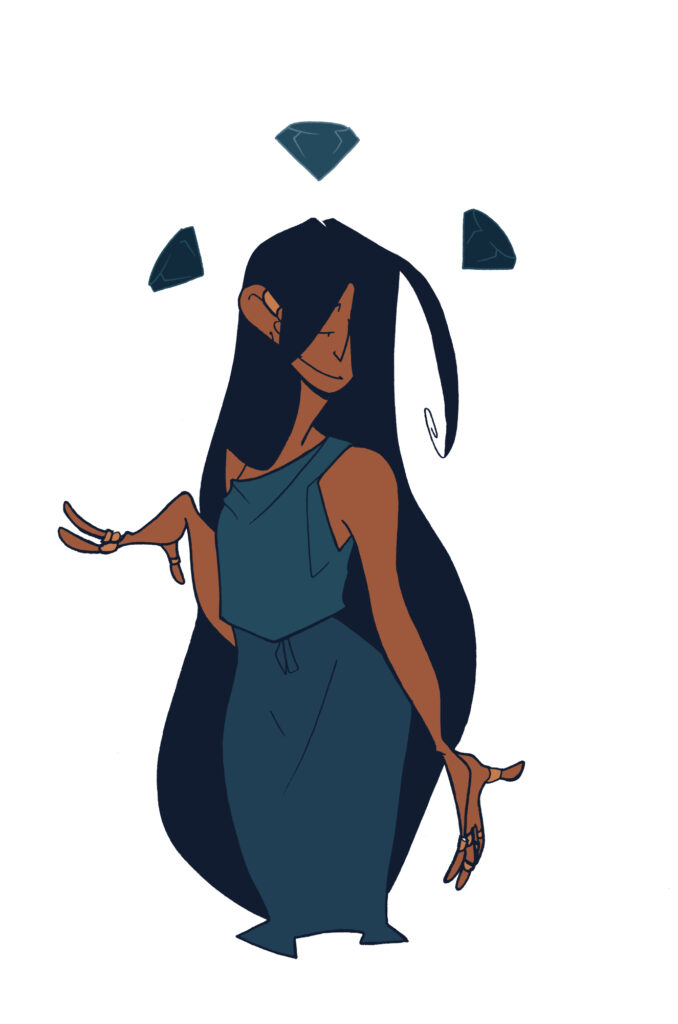
Theia
(THEIA/THEA/THIA/EURYPHAESSA/AITHRE/AETHRA)
Titaness of sight and the ‘clear shining light of the blue sky’.
In some versions of the myth it was said she was the sister and wife to Hyperion which meant she was the mother of Helios, Selene and Eos. It was also said she was one of the eldest children of Gaia and Ouranos. Theia didn’t play a much greater role in myth other than a name to fill a void.
However, Theia was not only known as the titaness of sight/the sky but it was also said that she was responsible for giving gold and gems their particular shine and radiance.
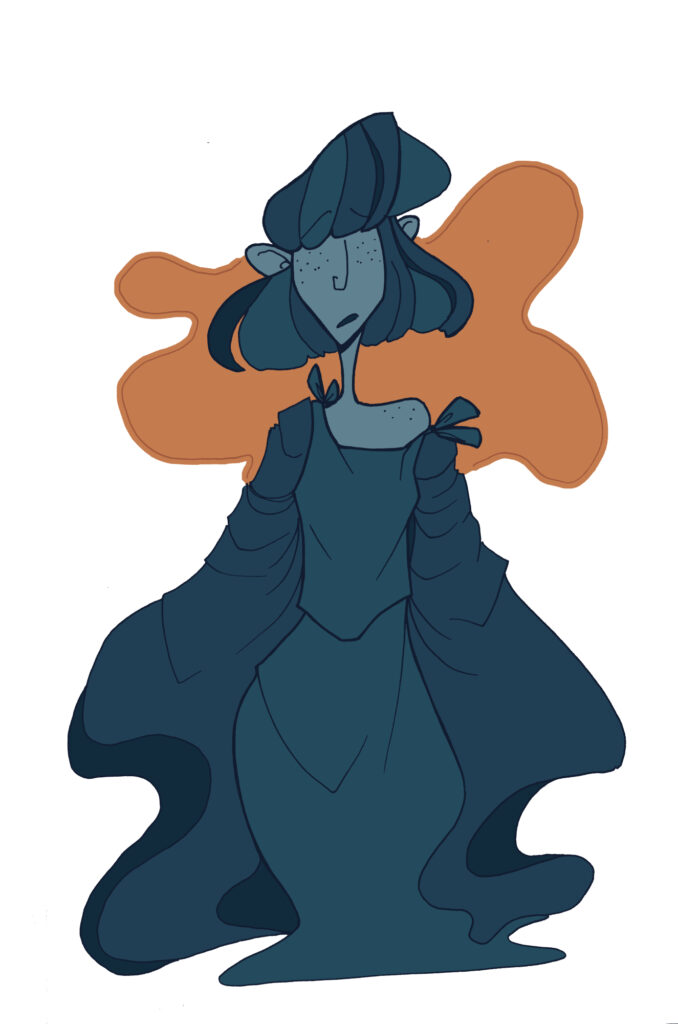
aura
(AURA/AURAE)
Titaness of the breeze and the fresh cool air of the morning.
In some versions of the myth Aura was often represented either as a ghostly entity or an amalgamation of several. She was often confused with the souls of the departed because she was always seen with billowing cloth and blended with the wind. It was said she could control the wind probably better than the designated wind-gods could.
Aura was also a part of a most unfortunate myth in which she hunted alongside Artemis, and in a small break compared herself to the moon goddess. Aura made a light mockery of her and her supposed virginity causing a rage in Artemis in which the goddess orchestrated a plan with Nemesis in which Dionysos should take advantage of Aura. The plan works horrifically well and causes a rage so rampant in Aura she murders any and all men she sets her eyes on. Later she devours one of her own children in an attempt to rid herself of the evidence of the horrors she faced.
In other versions of her myth, Aura is much less scene and heard and is instead more of the concept of the morning breeze after the hunt.
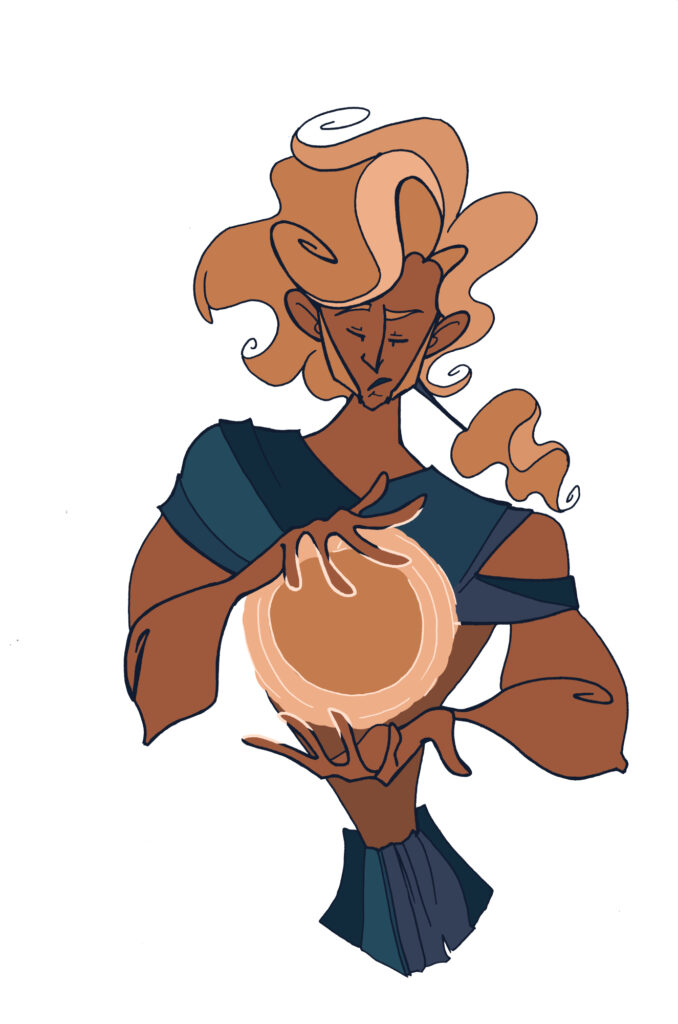
hyperion
(HYPERION/ANDES)
Titan of watchfulness, wisdom and light.
In some versions of the myth it was said that Hyperion helped Kronus in the conspiracy that castrated their father in order to help free Gaia of his embrace. He was one of the titans who helped pin Ouranos down while Kronus did the horrid deed.
Hyperion then fathered; Helios, Selene and Eos. Some myths use Helios as a means of usurping Hyperion as the sun god, others hold a very firm distinction in that Hyperion’s role wasn’t as the sun but the general concept of light and the sun’s gaze. Hyperion was generally only made mention of, during this time period.
Later, in the Titanomachy war, Hyperion was hardly even mentioned as playing any sort of part in the entire debacle, perhaps opting to keep quiet and slide by unnoticed and unscathed. This seemed to work rather well for him.
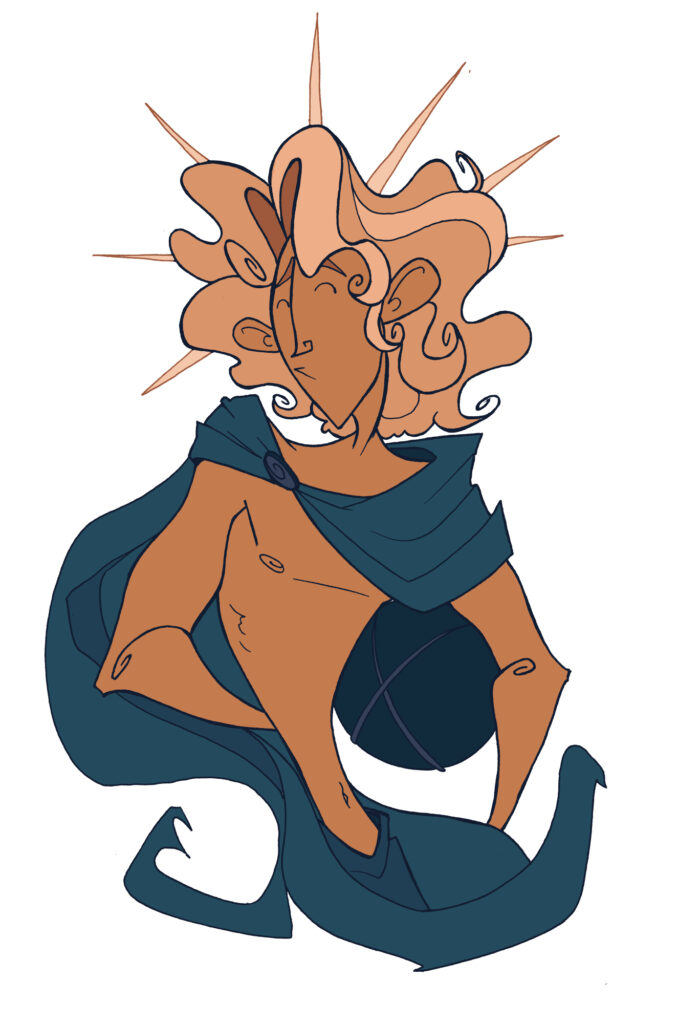
helios
(HELIOS/HELIUS)
Titan of the sun.
In some versions of the myth, Helios was considered a very handsome young man with a golden crown who was the humanoid concept representing the sun. It was said that Helios drove a golden chariot with four (named) horses: Pyrios, Aeos, Aethon and Phlegon, across the sky until the sun set for the evening.
In one myth his son takes his chariot and nearly destroys the world by losing control and bringing the sun too close as to burn various crops. In another, Helios, having been the sun was also often given the ‘surname’ Panoptes meaning, ‘all-seeing’ and was the one who caught Aphrodite cheating on Hephaistos and told him about the treachery. In a final myth, Odysseus kills some of Helios’ prized cattle and the titan appeals to Zeus, insisting he must kill Odysseus for his mistakes. Zeus gives in to his complaints and strikes Odysseus’ ship killing his entire crew (except Odysseus).
While Apollo was the god of the sun, the two were only ever conflated in a few recountings of myth. Often Helios was predominantly a representation of the actual sun, while Apollo veered towards a ‘god of the sun’ with his own other responsibilities added on.
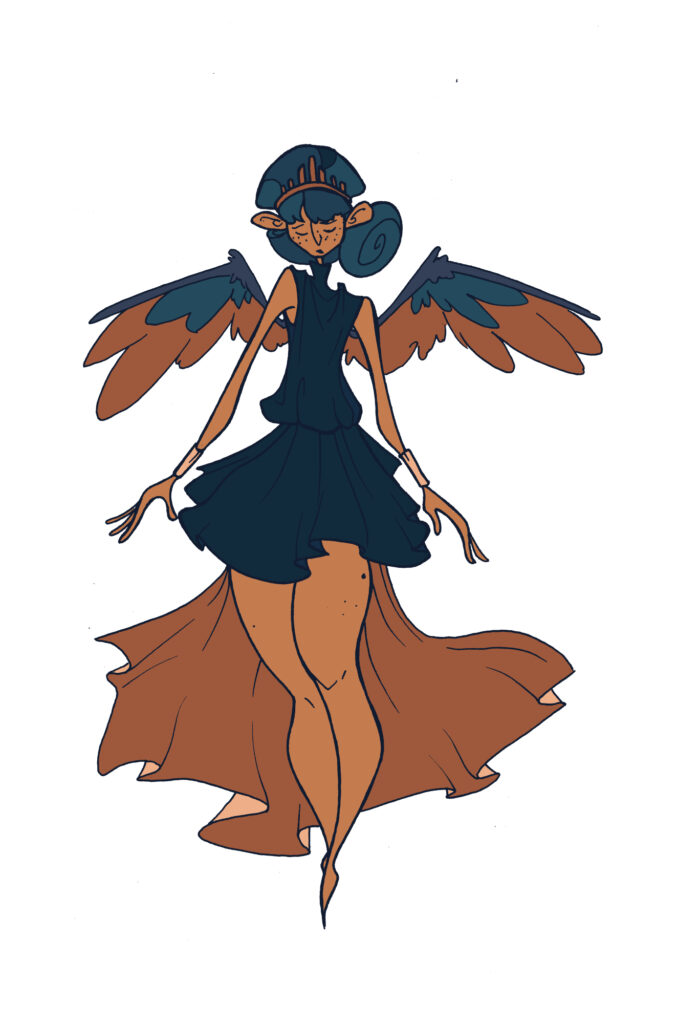
Eos
(EOS)
Titaness of the dawn.
In some versions of the myth, Eos was the one in charge of opening the gates of heaven in order to free the sun from its nightly slumber. She rode her own chariot across the sky, supposedly preceding Helios with her own magnificent steeds. Eos was wed to Astraios and bore the winds and the morning star.
It was also noted in myth that Eos was a bit of a troublesome sort of her own. In order to create jealousy with Aphrodite, she slept with Ares. This petty plan worked and Aphrodite cursed her into an unsatisfiable sexual desire. Eos was known for kidnapping a lot of young men in an attempt to satisfy this desire each attempt to no avail.
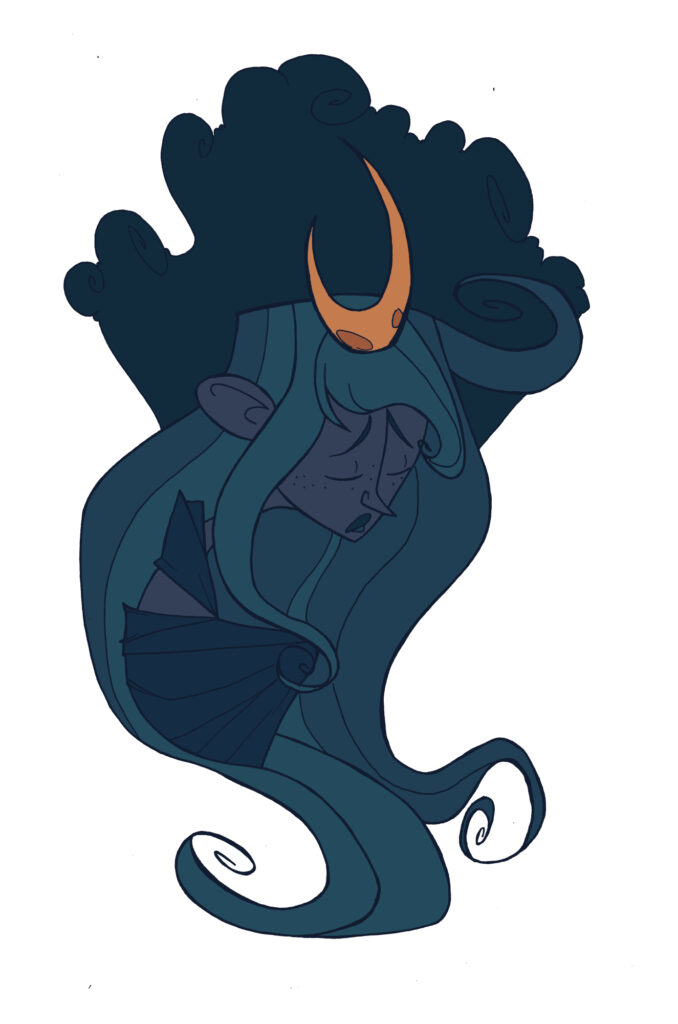
selene
(SELENE)
Titaness of the moon.
In some versions of the myth, Selene was also known for having a chariot to drive across the sky bringing night. The creatures that drover her chariot were either white horses, oxen or bulls and she was only graced with two of these creatures rather than the four creatures her brother was given.
Although Selene did have relations with Zeus and Pan, she was most commonly known in having an innate infatuation with the mortal Endymion, spotting him one night and was greatly determined to make him her very own. She cursed him to an ageless slumber in which she released her infatuations upon him.
Like her brother, Selene was often paired with Artemis, both being patrons of the moon. Selene, while primarily the personification of the moon itself was distinguished by that mere fact. She was also conflated with the titaness-witch Hekate who was also considered a goddess of the moon.
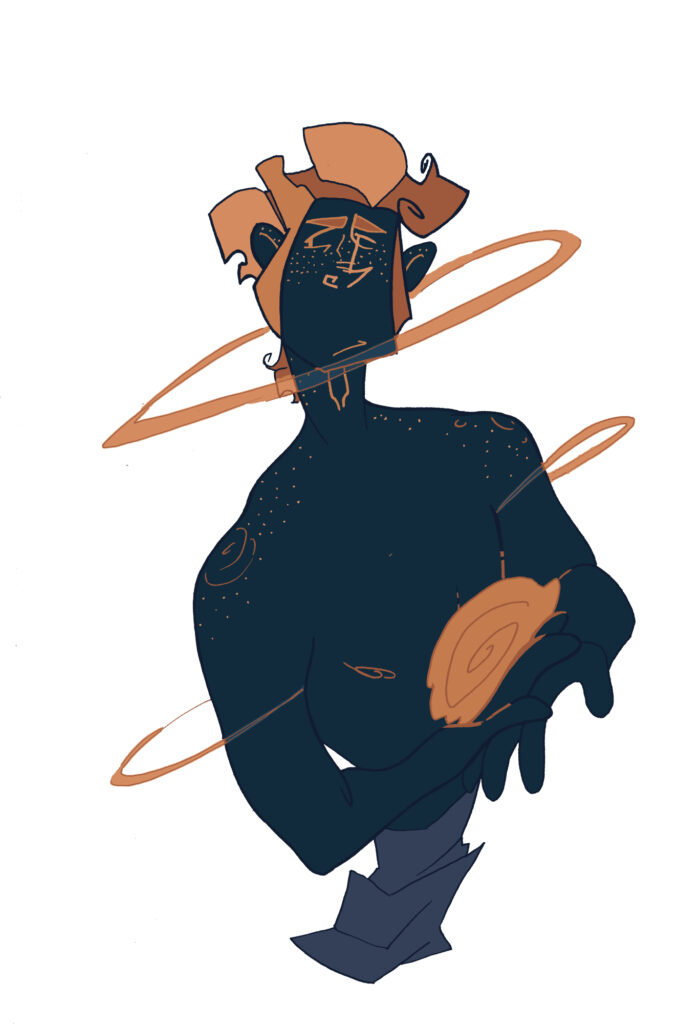
Astraios
(ASTRAIOS/ASTRAEUS)
Titan of the dusk, stars and planets.
In some versions of the myth Astreios was known as the father of the four winds (often conflated with Aiolos who was later considered to be the true father of the four winds). In some versions he was the descendent of Kreios and Eurybia though others insist he was created by Gaia and Tartaros as a Giant.
With Eos, he was not only known for having the four winds as children but also children based off the ‘wandering stars’ (what is considered today as: planets). Each of these children were named: Stilbon (Mercury), Eosphoros (Venus), Pyroeis (Mars), Phaethon (Jupiter) and Phainon (Saturn). Aside from all these sons, he was also said to have created a daughter named Astraea who was known as the goddess of innocence and (occasionally) justice.
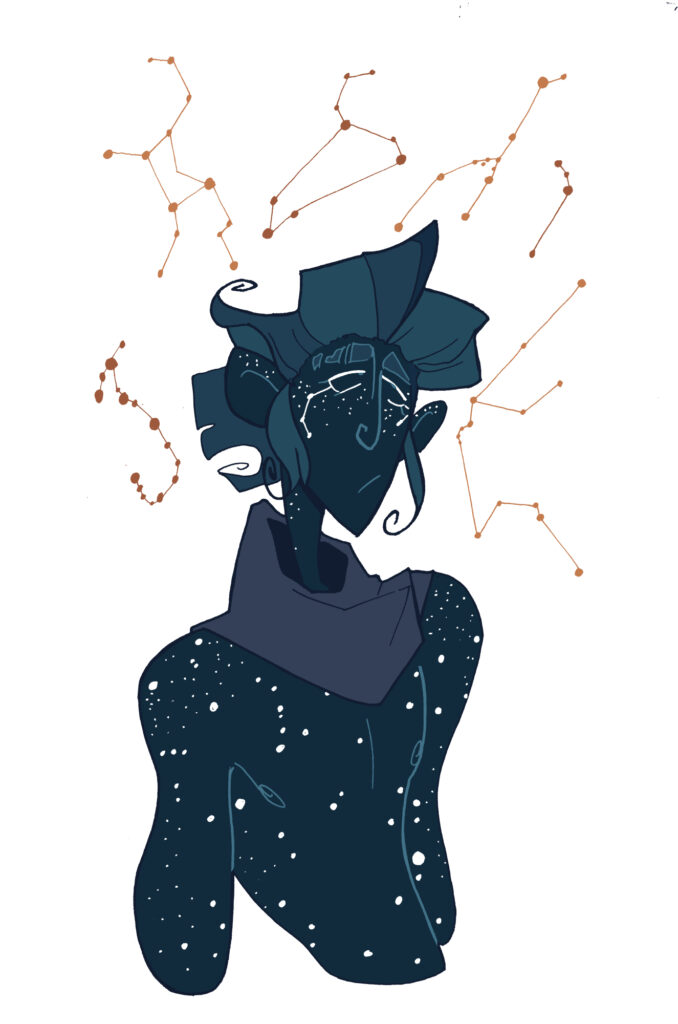
kreios
(KREIOS/KRIOS/CRIUS/MEGAMEDES)
Titan of constellations.
In some versions of the myth, Kreios was initially one of the titans who aided Kronus in the castration of their father to save Gaia. Kreios was one of the possibly least mentioned Titan of mythology. His name was dropped as the lover to Eurybia and was possibly the father to: Astraios, Eos, Perses, Asteria, Pallas and Styx.
The final real mention of Kreios was his part in the Titanomachy as siding with Kronus and thus losing the battle. He was sentenced to an eternity in Tartaros like the rest of his siblings and family.
Oddly enough the idea of Kreios as a concept was rather interesting and it seems odd that he wasn’t a titan of much greater stature considering the way the ancient folks tended to rely greatly on constellations in their storytelling, navigation and astrology.
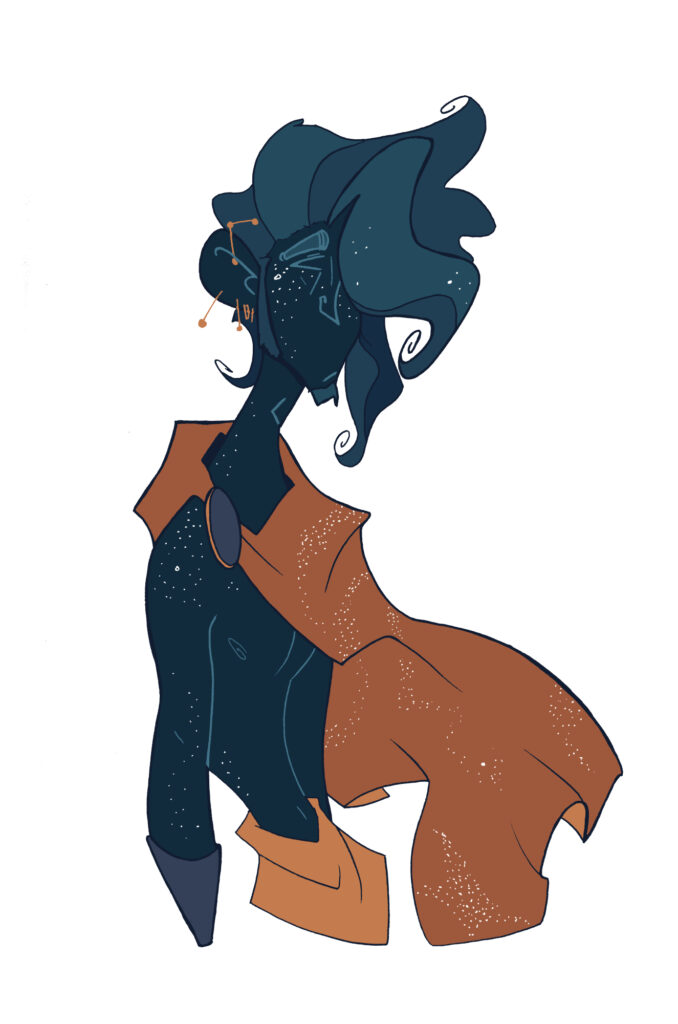
koios
(KOIOS/COEUS/POLUS/POLOS)
Titan of intellect and was the axis the heavens and the constellations revolved around.
In some versions of the myth, Koios was married to his wife Phoebe and, like his brother; Kreios, Koios wasn’t very prominent in mythology. It was considered, however that since he was the titan representing rational intelligence while his wife represented prophetic wisdom the couple may have been considered the origin of all thought and knowledge.
More concretely, however, Koios also participated in the Titanomachy, siding with the titans and thus losing the war and was tossed into Tartaros with the others. Koios was said to also have gone mad, having been locked away for so long, and broke free of his bonds. The titan sprang to freedom, only to run face-to-face with Hades’ three-headed dog; Keberos and wound up being hauled back into his prison.
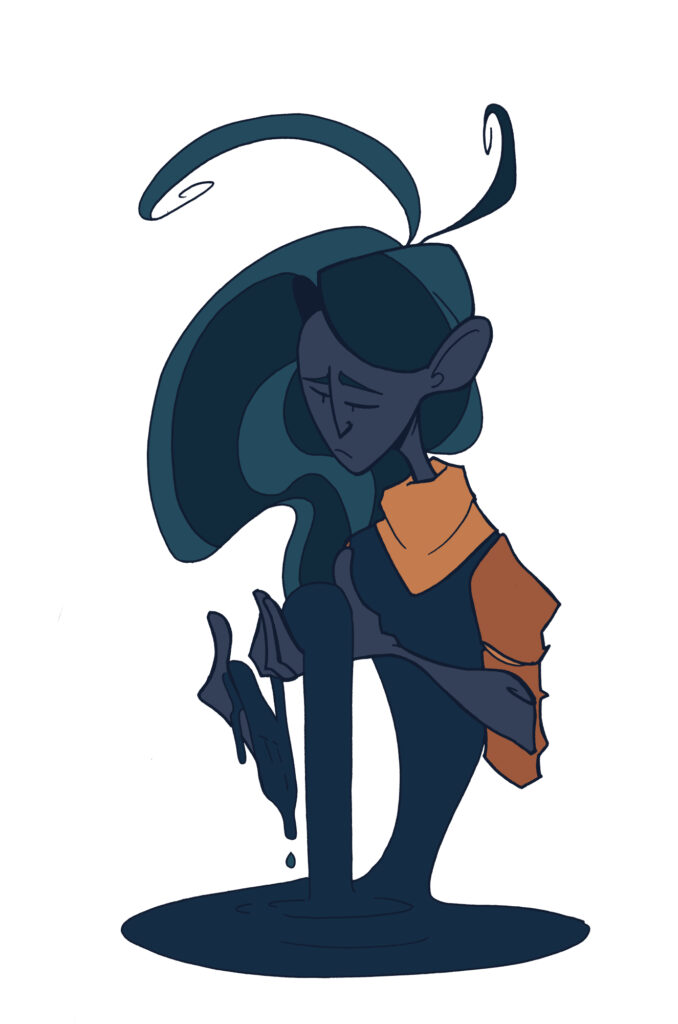
eurybia
(EURYBIA)
Titaness of the mastery of the seas.
In some versions of the myth Eurybia was born from Pontus and Gaia which meant that her strengths were in the taming and mastery of the seas. She maintained the balance and imbalance of the waves using the wind and the rise of the constellations. The latter of the two meant that her companionship with Kreios was a rather excellent match as they could worth together in achieving success in their intents. Eurybia was also a rather ancient Titan who mostly kept to her own devices. It was fairly safe to say that she perhaps sided with Kreios in the Titanomachy and was also sentenced to an eternity in the pits of Tartaros but even this assumption is only that. An assumption.
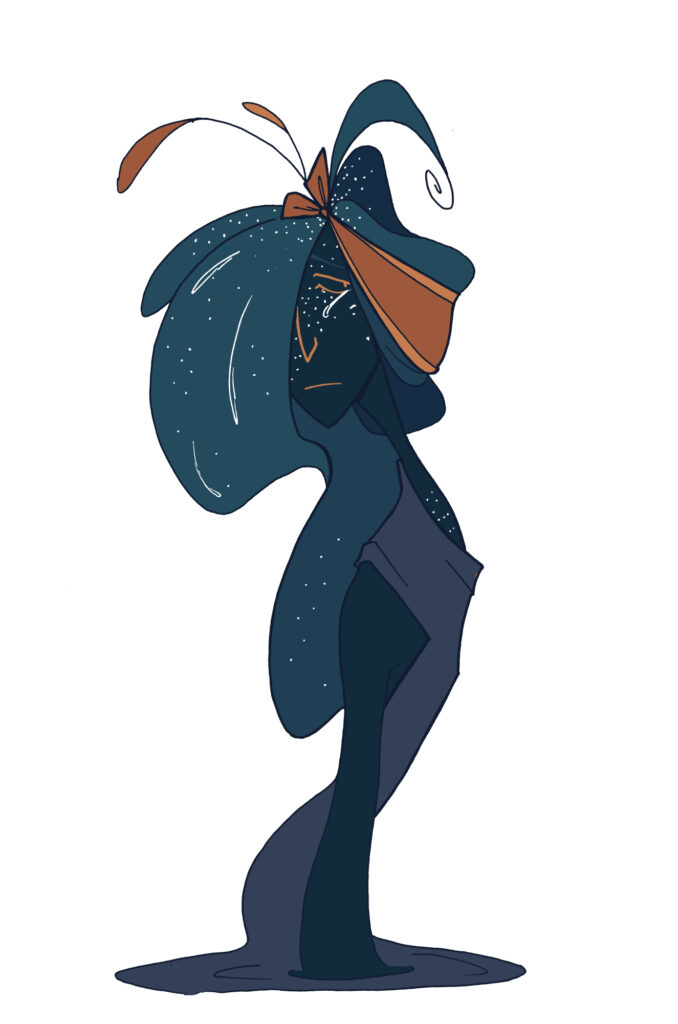
asteria
(ASTERIA/ASTERIE)
Titaness of nocturnal oracles and falling stars.
In some versions of the myth, after the Titanomachy, Asteria resided on Olympus and was ‘beloved’ by Zeus who would not cease his incessant advances towards her. In order to avoid and be free from his sights, Asteria fled, transforming herself into a quail before promptly diving into the Aegean Sea. Over the following years, Asteria transformed herself into an island initially known as Asteria itself before the name through the year became Delos.
This same island, years later was the same island Leto took refuge in to save herself from Hera’s scrutiny and give birth to her (and Zeus’) children.
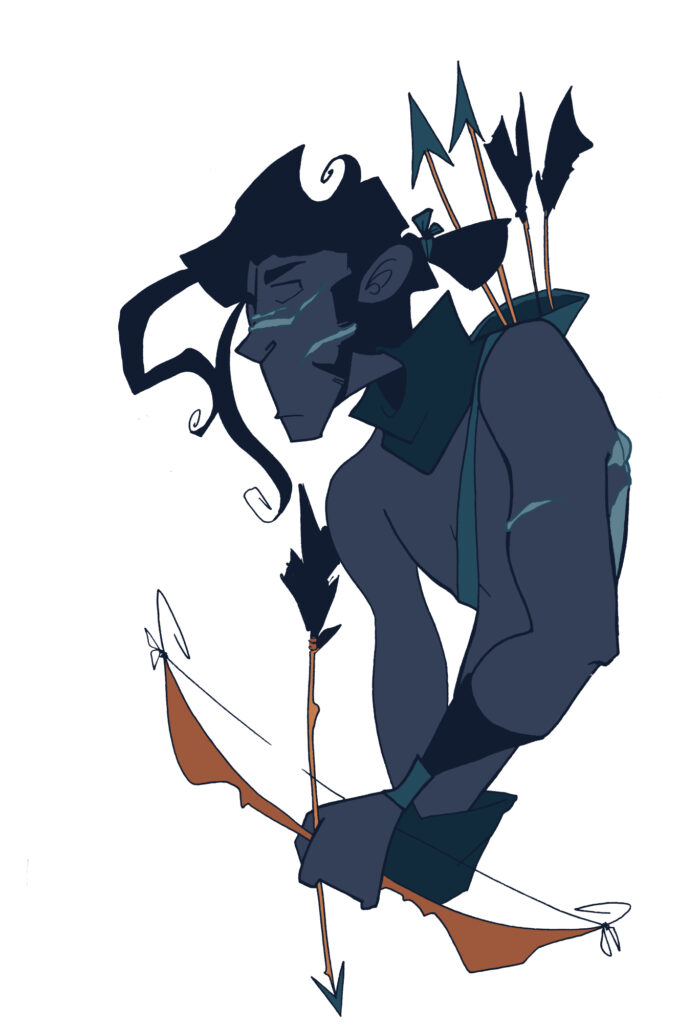
lelantos
(LELANTOS/LELANTUS)
Titan of air, the ‘hunter’s skill of stalking prey’ and the unseen.
In some versions of the myth he was the son of Koios and Phoebe which meand he was the brother of Asteria and Leto. He was one of the titans the least mentioned in mythology which honestly made a great deal of sense as his name literally meant, ‘to escape notice/to move unseen’. It was very possible he was the sort of hunter-titan who set traps and remained an orchestrator from the shadows of his far more popular sisters.
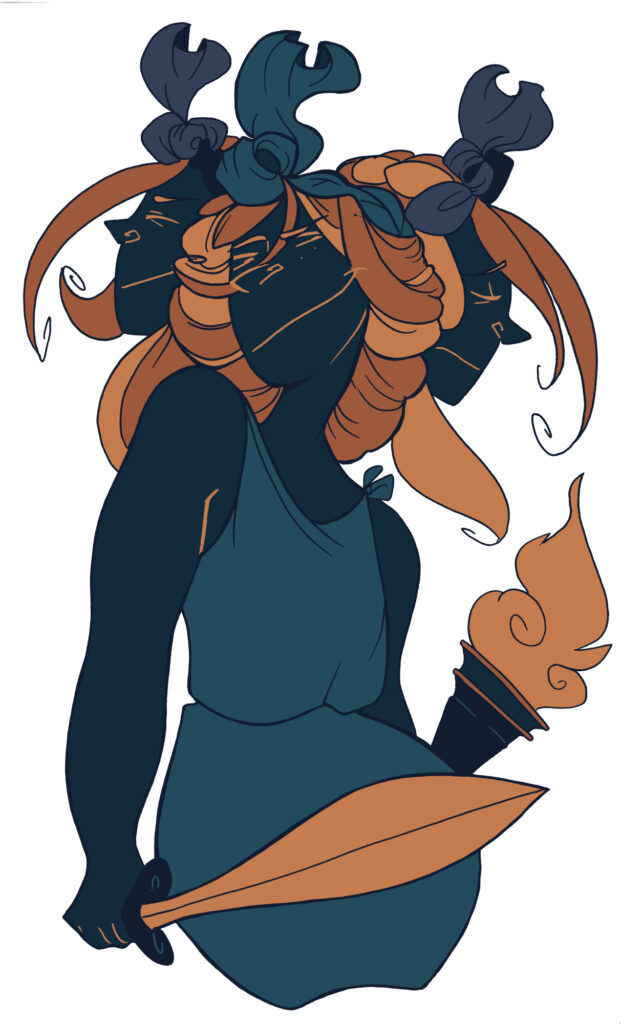
hekate
(HECATE)
Titaness of magic, witchcraft, the night, moon, ghosts and necromancy.
In some versions of the myth, Hekate was the sole daughter of Perses and Asteria and thus gained great power over the heavens, the earth and the sea. In some versions, because she was a second-generation Titan she did not participate in the Titanomachy, in other versions, however, it was said that she did participate and, instead of siding with her own kind, she veered towards favouring Zeus.
Later, Hekate assisted Demeter in her search for her lost daughter, Persephone, using her torches to light the way. After they found Persephone it was said Hekate became her minister and companion in the Underworld.
Her familiars were a black dog and a polecat (ferret). It was said that the black dog was the result of Queen Hecuba being transformed into the animal by Hekate after she leapt into the sea when Troy lost the war. Her polecat was the result of either a witch by the name of Gale who lacked any sort of control over her magical arts (or self-restraint when practicing them) and was turned into this creature as a punishment; the alternate it was said that her polecat was actually the Alkymene’s midwife who was turned into a polecat after she ratted Eileithyia out for preventing the birth of Herakles.
While Hekate only played small roles in actual mythology, she was a hugely well respected goddess in antiquity (so much so that she transcended the era of polytheistic religions in ancient Greece and was found in later stories of more Christianity-based faith.
Hekate was also important enough that she had various shrines often along with various other goddesses. It was said that she was identified with a number of goddesses including: Artemis, Selene, Despoine and various smaller deities often of the female persuasion. Her face was also said to have appeared on various ancient Greek coins.
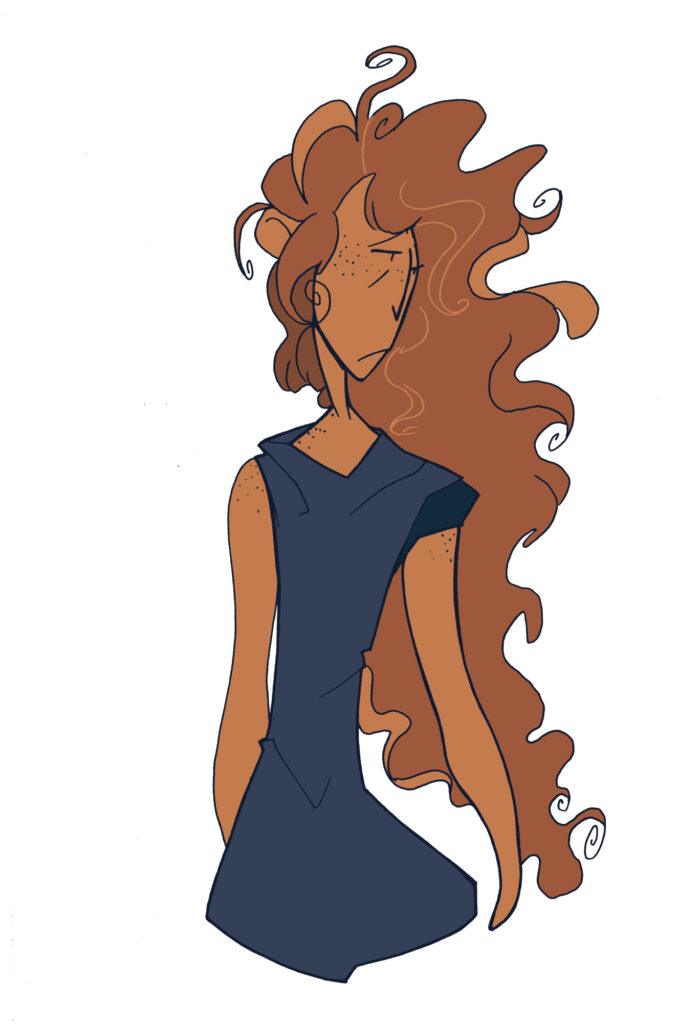
phoebe
(PHOEBE/PHOIBE/PHOEBOS)
Titaness of prophecy and oracular intellect.
In some versions of the myth Phoebe was best known as the grandmother of Artemis and Apollo, a trait so ingrained into her lineage, tellers of myth often also called her grandchildren: Phoebe and Phoebus.
In myth, Phoebe was given the control of the Oracle of Delphi by Themis. Phoebe was a very quiet sort and although not mentioned much save in ancestral accounts was mentioned enough to pinpoint that unlike her brother and consort, Koios, she refused to take part in the Titanomachy and kept her mind away from such an abhorrent distraction. She was then spared from banishment to Tartaros, having not taken part in any side of the argument.
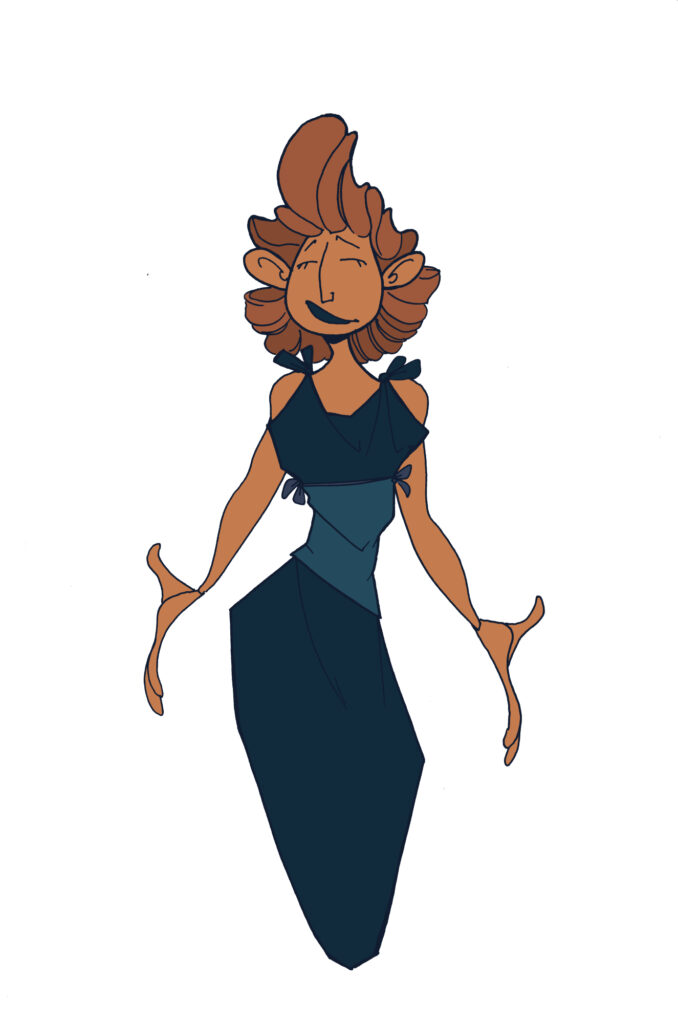
leto
(LETO/LATO)
Titaness of motherhood.
In some versions of the myth, her inner beauty shone bright enough to catch Zeus’ eye and his interest in her grew insatiable. Zeus slept with her and she was impregnated with the gods: Artemis and Apollo. Unfortunately, Hera learned of Zeus’ tryst and instead of laying all her anger on her uncontrollable husband, blamed Leto. She made it so that all the lands shunned Leto, causing her to flee in an attempt to find a birthing ground for her children. It was only to her luck that Asteria’s island which was made from the titaness and therefore not considered proper land (due to the fact that it was not connected to the ocean floor). Here Asteria, as the island of Delos, became her sister’s refuge so that she might give birth to two healthy god children. Much to Hera’s great disappointment, certainly.
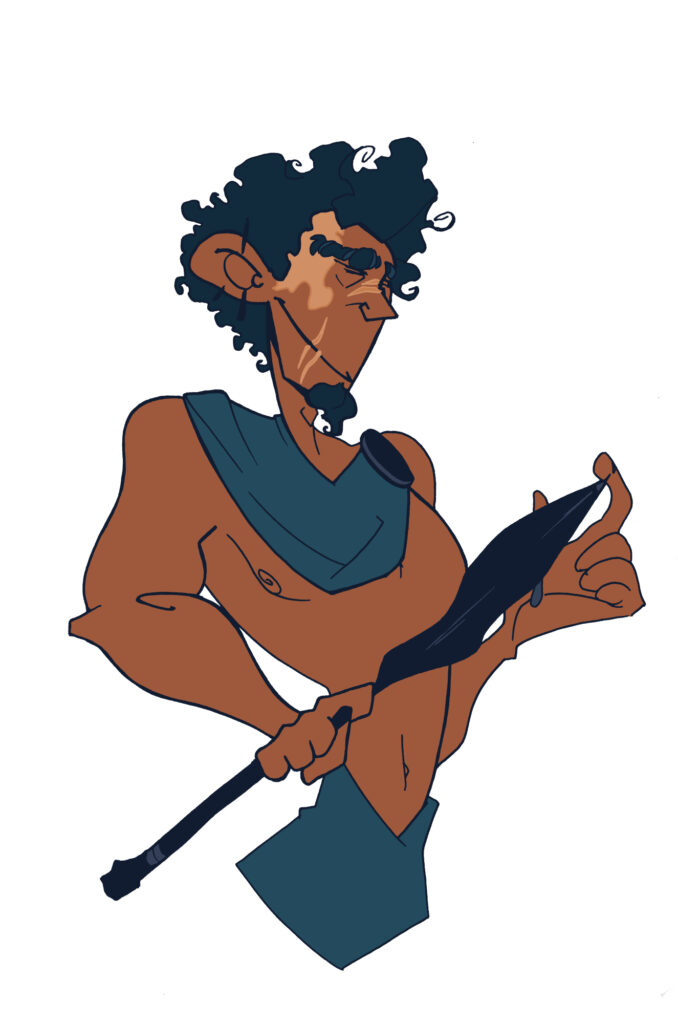
pallas
(PALLAS)
Titan of warcraft.
In some versions of the myth, Pallas was the husband to Styx and the son to Kreios and Eurybia. There were two main versions of his involvement in mythology and both of these versions involved Athena.
The first version was one in which Pallas and Athena were childhood friends and tended to play various games involving war. In one of their mock battles, Athena accidentally murdered Pallas and so his name was also added to hers: Pallas Athena.
In the second version this particular battle between the two occurred during the Titanomachy where, instead of being imprisoned for the entirety of eternity, Pallas was murdered at the hands of Athena in battle.
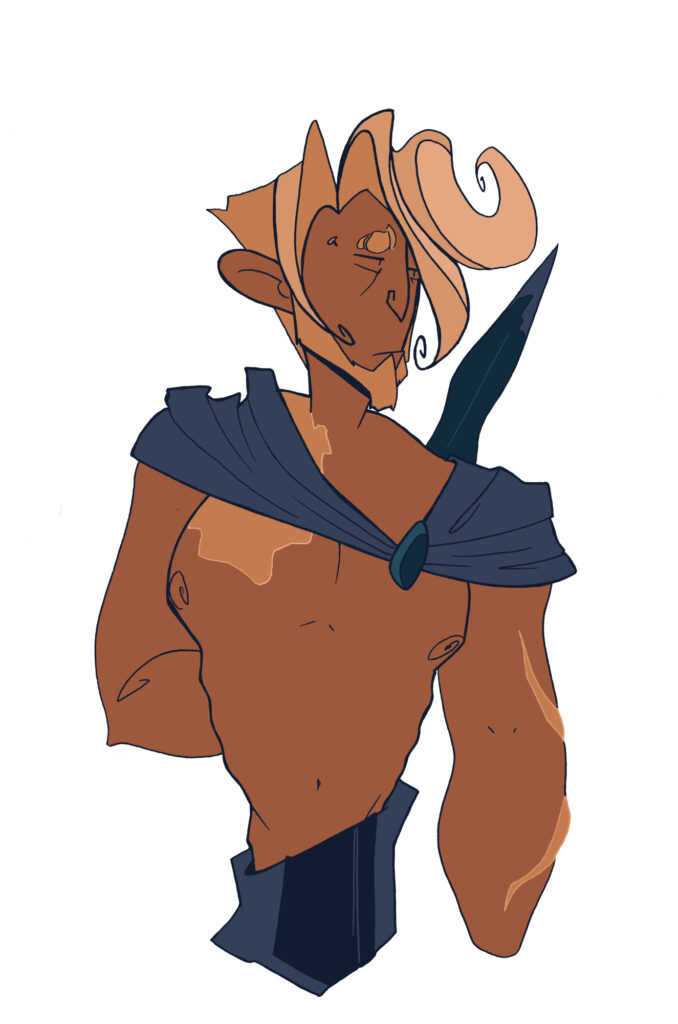
perses
(PERSES/PERSAIOS/PERSAEUS)
Titan of destruction.
In some versions of the myth Perses was the son of Helios and Perse, but sometimes he was the son of Kreios and Eurybia, married Asteria and was the father of Hekate.
The former lineage brings about a mildly more involved story in mythology in which Perses stole the throne of Colchis from his brother, Aeetes. Later he was murdered by his own niece, Medea.
Considering Perses’ title as the titan of destruction, it was rather interesting to know that Perses was hardly mentioned in the Titanomachy whatsoever, let alone having played any sort of prominent role.
MAIN PAGE | PRIMORDIALS | GODS | HEROES | LADIES | LOVERS | MONSTERS